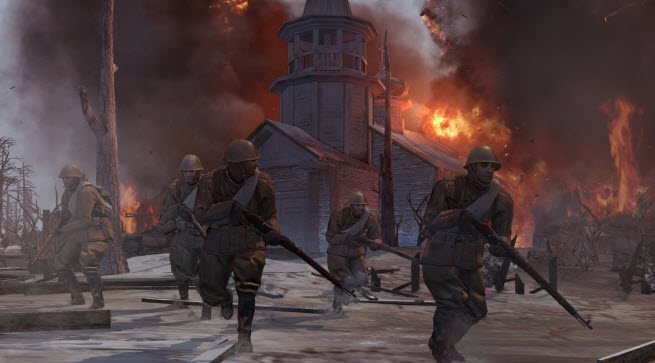On the frozen terrain of the Eastern Front, Germany suffered more than 80 percent of its casualties in World War II. That grim fact is reflected in the brutal combat of the upcoming Company of Heroes 2, which THQ plans to publish on the PC next year.
The original Company of Heroes was one of the best real-time strategy games of 2006. I played the entire game, and it was one of my favorites of the year. It covered battles on the Western Front after the American invasion of France. But Company of Heroes 2 will cover a longer span: from 1941 until the storming of Berlin in 1945.
“For Company of Heroes 2, we wanted to be different, to do more, add more authenticity, realism, immersion, and dynamic tactical battles,” said Quinn Duffy, lead designer of the Relic Entertainment-developed game.
 Duffy showed a group of journalists a scene from the Rzhev meatgrinder.The 3D art work is more detailed and more beautiful than in the first game, and the level of realism is almost as good as what you would find in a modern first-person shooter. The game uses the Essence 3.0 Engine, which improves graphics quality and accuracy of combat via a system dubbed TrueSight.
Duffy showed a group of journalists a scene from the Rzhev meatgrinder.The 3D art work is more detailed and more beautiful than in the first game, and the level of realism is almost as good as what you would find in a modern first-person shooter. The game uses the Essence 3.0 Engine, which improves graphics quality and accuracy of combat via a system dubbed TrueSight.
Company of Heroes 2 blends cinematic cutscenes (like the one at top) that zoom in on dialogue between soldiers and their commanders. In one battle, the Soviet soldiers retreat from a German attack, only to be gunned down on the command of a Russian officer. The cinematic blends into the real-time environment of the game, which is viewed from an overhead isometric angle.
When you pull up above the scene, you can see the snow-covered terrain and barren trees around Russian farmhouses. But if you zoom in on the soldiers, you can see that their legs vanish into the deep snow. Duffy said the depth of the snow comes into play because soldiers can’t run through deeper snow.
 In one attack, the Russian soldiers crawled toward a German position and were met with a rain of artillery shells. When the two armies got close enough to exchange fire, a pitched battle began. Then the Russians brought out a flamethrower and roasted the Germans inside the farm house. That means that the cover system, while effective, is also dynamic. It changes as the battle takes its toll on the buildings.
In one attack, the Russian soldiers crawled toward a German position and were met with a rain of artillery shells. When the two armies got close enough to exchange fire, a pitched battle began. Then the Russians brought out a flamethrower and roasted the Germans inside the farm house. That means that the cover system, while effective, is also dynamic. It changes as the battle takes its toll on the buildings.
You control groups of soldiers in small squads. The action unfolds without your direct control, but you can engage in tactical decisions such as ordering soldiers to lob grenades. If solders are flanked and in the open, they’re likely to start dropping like flies when fired upon. If they’re in protected cover or are crawling, they can probably escape German machine gun nests. Soldiers who are pinned down can be aided by teams that go around the side. And the army that brings up heavy armor first can gain a big advantage. While you won’t fight every single battle of the war on a tactical level, the game will put you at the turning points of pitched battles where the individual bravery of each soldier mattered.
THQ also said it will have competitive and cooperative multiplayer sessions, though it didn’t show any of that yet.
VentureBeat's mission is to be a digital town square for technical decision-makers to gain knowledge about transformative enterprise technology and transact. Learn More


